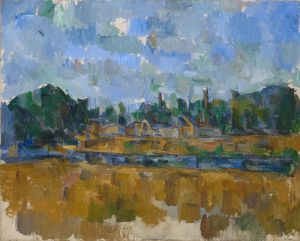
Sous-bois
A hand-painted replica of Paul Cézanne’s masterpiece Sous-bois, meticulously crafted by professional artists to capture the true essence of the original. Each piece is created with museum-quality canvas and rare mineral pigments, carefully painted by experienced artists with delicate brushstrokes and rich, layered colors to perfectly recreate the texture of the original artwork. Unlike machine-printed reproductions, this hand-painted version brings the painting to life, infused with the artist’s emotions and skill in every stroke. Whether for personal collection or home decoration, it instantly elevates the artistic atmosphere of any space.
"Sous-bois" is a painting by the French Post-Impressionist artist Paul Cézanne. Created around 1894, this work is an exemplary piece that showcases Cézanne's innovative approach to landscape painting, which would later influence the development of modern art.
Paul Cézanne, born on January 19, 1839, in Aix-en-Provence, France, is often credited with bridging the gap between late 19th-century Impressionism and the early 20th century's new line of artistic inquiry, Cubism. His unique method of building form with color and his analytical approach to nature influenced the aesthetic development of many 20th-century artists and art movements.
"Sous-bois," which translates to "Underwood" or "Wooded Area," depicts a forest scene. The painting captures the dense, leafy undergrowth of a forest, with a focus on the interplay of light and shadow filtering through the trees. Cézanne's technique in this painting is characterized by his use of short, hatched brushstrokes and a palette dominated by greens and earth tones, which create a sense of depth and texture.
Cézanne's approach to "Sous-bois" reflects his broader artistic philosophy. He sought to depict the natural world in a way that conveyed its underlying structure and form. Unlike the Impressionists, who often focused on capturing fleeting moments and the effects of light, Cézanne was more concerned with the solidity and permanence of the objects he painted. This is evident in "Sous-bois," where the forms of the trees and foliage are rendered with a sense of weight and stability.
The composition of "Sous-bois" is carefully constructed. Cézanne often worked slowly and deliberately, building up the surface of his paintings with multiple layers of paint. This method allowed him to achieve a rich, complex surface texture and a sense of depth that draws the viewer into the scene. The painting's composition is balanced, with the dense foliage creating a natural frame that guides the viewer's eye through the forest interior.
Cézanne's work, including "Sous-bois," was not widely appreciated during his lifetime. His style was considered unconventional, and he struggled to gain acceptance in the mainstream art world. However, his persistence and dedication to his vision eventually earned him recognition as a pivotal figure in the history of art. Today, Cézanne is celebrated as a master who profoundly influenced the course of modern art.
"Sous-bois" is housed in the Musée d'Orsay in Paris, France, which holds one of the most extensive collections of Cézanne's work. The museum's collection provides a comprehensive overview of Cézanne's artistic development and his contributions to the evolution of modern art.
In summary, "Sous-bois" by Paul Cézanne is a significant work that exemplifies the artist's innovative approach to landscape painting. Through his use of color, brushwork, and composition, Cézanne created a scene that captures the essence of a wooded area while also conveying a deeper sense of structure and form. His work continues to be celebrated for its profound impact on the trajectory of modern art.

















